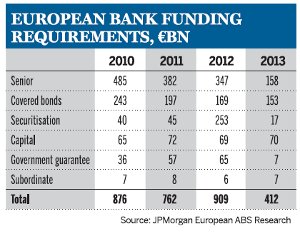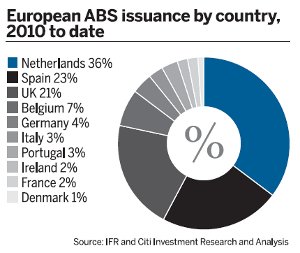Securitisation takes slow road to redemption
In early October, it was revealed that Alliance Bernstein's asset-backed securities funds had returned 23% in 16 months. The US asset-management firm was benefiting from the recovery of the US asset-backed securities market. David Wigan asks whether the European market is following suit.
The sharpest tool is always the most dangerous. The global financial boom was fuelled by loans to weaker borrowers and the distribution of that risk to investors. Securitisation was the tool that made it happen and, when the party turned sour, it was the scapegoat for the turmoil that followed.
As the financial markets went into meltdown, structured finance teams retreated into purdah, branded the unacceptable face of investment banking. Now, with the crisis seemingly abating, there are signs that structured finance may be returning to favour.
Scattered individual deals in late 2009 turned into a steady stream this year, culminating in September in the biggest transaction for three years - a £4.6bn (€5.3bn) retail mortgage-backed security (RMBS) from Royal Bank of Scotland (RBS). This deal, Arran Residential Mortgages Funding 2010-1, was reported to have met with enthusiasm in the investment community, pricing in line with expectations and attracting a wide range of interest from accounts in Europe and the US. On the face of it, the market was back with a bang, laying down a marker from which a jamboree of new issuance might follow.
The reality, however, is somewhat different. While Arran attracted 46 investors, the deal's structure, the information demanded by investors and the yield offered show that securitisation has a way to go before returning to the investment mainstream.
"The RBS deal is encouraging, but it's a small step on what is going to be a long road," says Rick Watson, managing director of the Association for Financial Markets in Europe. "The economics of securitisation are extremely challenging; many investors have disappeared and we are looking at a raft of regulation and a lot of uncertainty."
Securitisation traditionally plays a dual role, as a risk-transfer mechanism to obtain capital relief and as a funding tool. In the current environment, the former is impossible, because the economics of issuance dictate that large parts of any deal remain on the issuer's books, while the latter is achieved at a higher cost than almost any rival funding method.
Arran broke the mould for the recent trend in securitisation in that it was able to offload not only the highest-rated AAA mortgage risk, but also some mezzanine notes, rated AA. These were the first AA rated UK RMBS notes to be sold since the crisis, showing that banks have been obliged to hold the vast majority of risk in the portfolio, divesting themselves of only the best-quality assets.
The Arran deal was boosted by a conservative structure, with high levels of credit enhancement (18% at the AAA level) and a non-amortising reserve fund, giving investors ultra-sound layers of protection against asset deterioration. While RBS declined to go into the details of Arran's funding equation, the amount that investors demand to compensate for the risk of providing funding suggests that the economics of issuance must be extremely tight. With mortgage rates hovering at about 250 basis points (bps) over Libor, and the yield on AA rated RMBS tranches currently trading at about 205bps over the floating rate, there is not a huge amount of room for manoeuvre.
Rick Watson, managing director of the Association for Financial Markets in Europe
Bank funding challenges
Still, European banks face huge funding challenges, with €876bn of requirements this year, according to JPMorgan, and a further €1671bn before 2013, suggesting that it is sensible to tap as many sources of funding as possible.
"Certainly, cost is not the only factor in coming back into this [asset-backed securities] market," says Stephen Hynes, head of secured funding at RBS. "It does make economic sense from the perspective of funding diversification, and this is a quality asset and core tool to match asset profiles where you have mortgages."
Across Europe, the revival of securitisation is patchy, and is split between deals designed for the public markets (emanating mainly from UK and Dutch banks and German car makers) and those retained by issuers to be used as collateral against European Central Bank (ECB) repo operations. In the year to date, Dutch issuers account for 36% of the European market, Spanish issuers had 23% and UK issuers 21%, according to Citi. The UK and Netherlands accounted for the vast majority of public mortgage deals, while Spanish issuance was almost entirely retained for ECB repo funding. Italy has yet to issue a public deal since the credit crisis.
Dutch issuers are especially keen on securitisation because of the extra burden of over-collateralisation that the Dutch National Bank imposes on the natural alternative, which is covered bond issuance. Among the most active players has been Dutch lender Obvion, a joint venture of Rabobank Group and the Dutch civil-service pension fund ABP, which in September priced its third Storm RMBS deal this year. Meanwhile, in a sign of renewed confidence in the UK mortgage market, buy-to-let lender Paragon said in September that it would return to new lending.
ABS issuance fell off sharply in the middle of the year, amid concerns that sovereign risk prompted by the Greek debt crisis had spread into the securitisation market. Sovereign risk again reared its head in late September/early October as Irish banks came under pressure, pushing spreads wider and causing what one analyst branded "investor fatigue" in the securitisation market. "Sovereign risk has to be considered," says Flavio Marco Rusconi, credit strategist at JPMorgan. "With sovereign spreads as the 'anchor price' for many other assets in the credit and rates markets, any prolonged period of volatility in pricing is expected to feed into ABS volatility."
Not going public?
Year-to-date issuance in the European asset-backed securities (ABS) market amounts to €202bn, of which €61bn were public deals. Two-thirds of the total were RMBS transactions, with about €50bn of that going public. In absolute terms, ABS issuance has dropped compared with 2009, when there was €430bn of issuance for the year. The key difference is in the level of public deals, which was just €9bn in 2009, the rest being retained for ECB funding. Among signs that European banks are becoming less reliant on the ECB was the news at the end of September that Santander had closed the retained portion of its Holmes Master Trust.
Still, the low proportion of public to private deals shows there is some way to travel before Europe once again has a fully functioning securitisation market. Key in the RMBS space is the drive to attract more investors to the asset class, after the demise of the structured investment vehicles, collateralised debt obligations and asset-back commercial paper conduits that made up a large proportion of the demand before the crisis.
"A lot of these buyers [from before the crisis] are simply not around any more and are not expected to come back," says Stuart Jennings, structured finance credit officer at ratings agency Fitch. "Who is going to replace these investors? There is a stigma in relation to structured finance generally, stemming from [the] US subprime [crisis], so it's more difficult for arrangers to convince investors to take part."
Approximately 40% of the pre-crisis ABS investor base is currently active in the market, according to analysts at Citi, equating to a capacity constraint of about €190bn of new issuance a year. The anaemic investor landscape was exemplified by a recent deal from Friesland Bank of the Netherlands, known as Stichting Eleven Cities No 5, which was only partially placed with investors and at the wide end of guidance, showing that "not all deals will stick", according to Citi analysts.
Stuart Jennings, structured finance credit officer at ratings agency Fitch
Deal structures
Some investors reluctant to engage in the European ABS market have focused on deal structures as a reason not to get involved. Unlike in the US, where standalone deals are the norm, European securitisations are largely run off 'master trust' programmes. Master trusts allow issuers to sell multiple bond issues off an asset pool that is actively managed and constantly evolving, a much more difficult set of underlying assets to analyse than the static pools seen in the US.
In addition, the master trust programmes are subject to non-asset triggers, such as the minimum share of the seller, that if breached can lead to early amortisation and large losses for investors. It was the breach of a non-asset trigger that led to the demise of Northern Rock's Granite funding vehicle, at one time the biggest funder of the UK mortgage market.
"We have reservations about the master trust format," says Georg Grodzki, head of credit research at L&G Asset Management. "After the crises, it would be preferable to have a closed-end pool of mortgages and the non-asset triggers are not great."
Investors may also be keeping their powder dry ahead of forthcoming new regulation for the structured finance market. The US Federal Deposit Insurance Corporation and European Commission are pressing ahead with rules that will require sellers of securitised assets to retain at least 5% of any transaction, and from December investors must prove that they have conducted due diligence and that they have analysis and risk management processes in place. There will also be increased capital requirements, additional disclosure and minimum levels of liquidity.
"To get investors comfortable again, we need to see these infrastructure improvements come through," says Mr Watson. "Issuers will need to be ready to provide the right data and be transparent in pricing, and all of that is going to take time."






